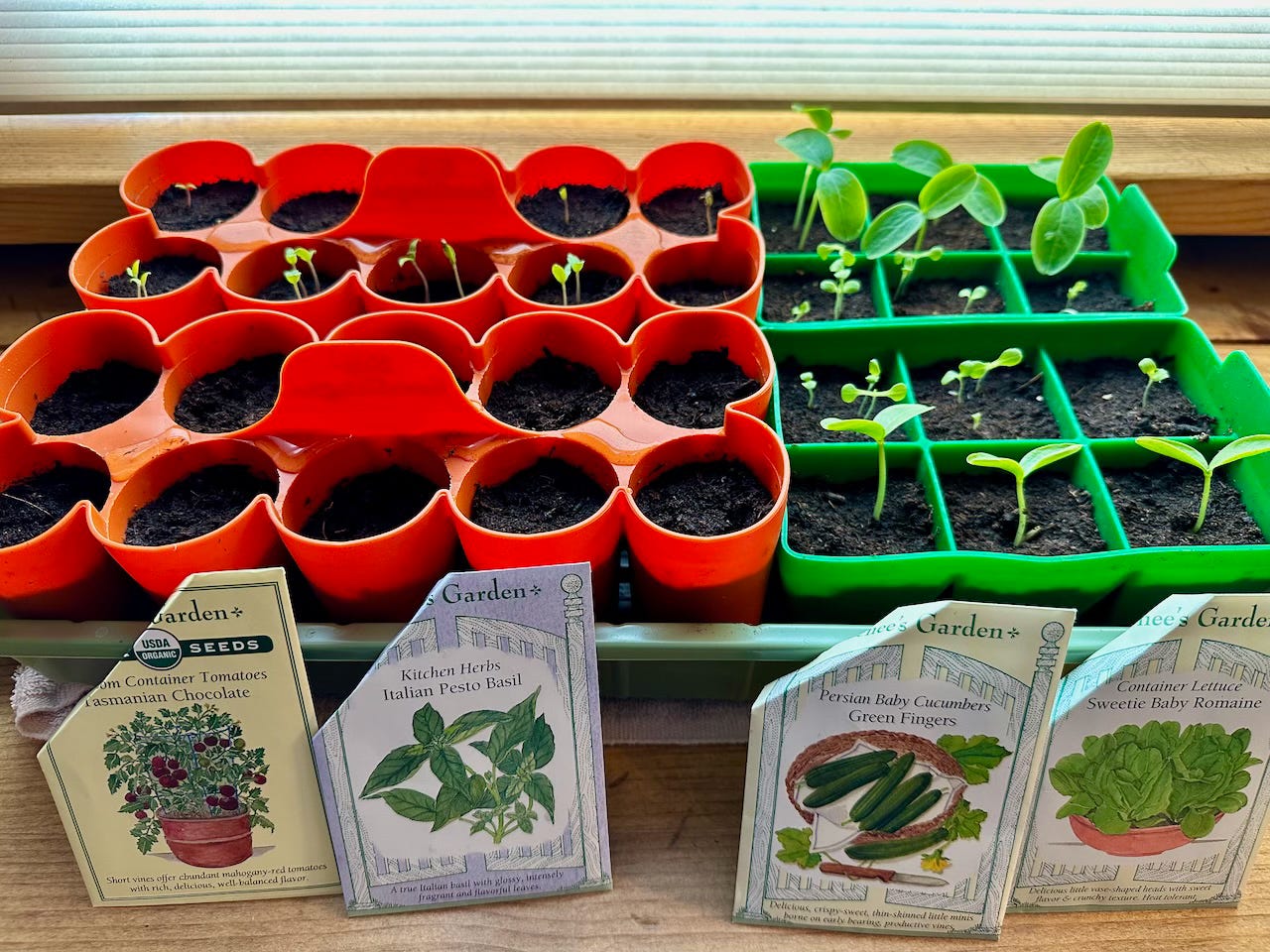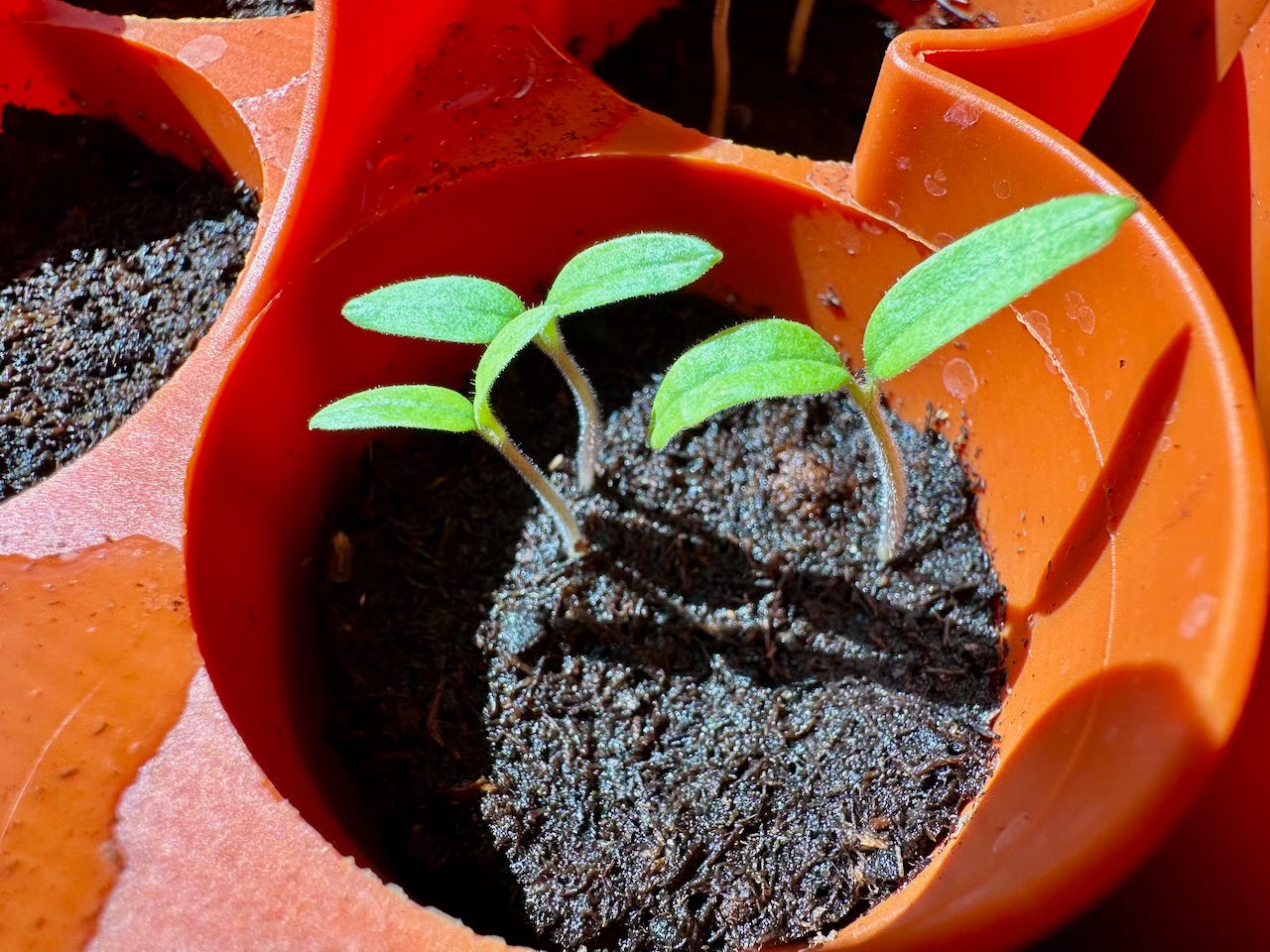vivid green cucumber cotyledons pop ready for life
Seedlings for my summer garden. They may be a bit early and they are surely very enthusiastic, but it’s exciting to see new life appear.
Hello Friends! It’s Wednesday and regardless of whatever bad news is swirling around, it’s time to exercise our gratitude muscles. Practicing gratitude helps us do more than survive in difficult times—it helps us thrive.
Research shows that the exercise of noteing something we are grateful for improves our health—physical, mental and emotional—and lifts our spirits and mood. That helps us to be kinder to those around us, which of course, has a ripple effect of the beneficial sort. So take note of what you’re grateful for, and envision the lovingkindness you spread through the world as a small tsunami of the positive sort.
Home and Sick
I’ve been sick since I returned from the Landscaping with Colorado Native Plants conference in Boulder a week ago, and oddly, I’m grateful for that because the enforced slowing down has meant I’ve been thinking about something I’ve resisted contemplating for well, ever.
There’s nothing like being miserable and exhausted to keep me from my usual mode of going full-tilt-boogie at every single moment of my waking life.
(Really, you’d think I could just learn to slow down! But no. It’s not that easy to undo the habits of nearly seven decades of feeling like I have to run faster because I was always the smallest and slowest….)
Being sick has forced me to slow down and examine what I’m doing and whether it’s right for me. Or more precisely, right for me now. So the sick time has given me contemplative time, and I’m still chewing over what is coming up. More on that in this Sunday’s reflection.
Garden Seedlings
The other thing I’m grateful for right now is what’s sprouting on a sunny windowsill in the guest bedroom at my house: seedlings.
Specifically, Tasmanian Chocolate tomato, Genovese basil, Persian Fingers cucumber, and Sweetie Baby romaine lettuce seedlings. (Thank you, Renee’s Garden Seeds!) All are for the raised-bed edible garden in a stock tank I will plant in about six weeks, and then cover lovingly every night to keep my baby edibles from freezing to death.
Planting seeds and watching them germinate always seems like a miracle to me. That a tiny seed—the tomato seeds are smaller than a period in 12 pt Times Roman type—could sprout into cells that know to grow downward and become roots, and others that grow upward and diversify into stalk and leaves seems like a miracle.
That a tiny seed could sprout into cells that know to grow downward and become roots, and others that grow upward and diversify into stalk and leaves seems like a miracle.
Further, that some of the root cells become tough exterior layers and others become rootlets capable of harvesting water and minerals from the soil, and still others become vascular tissue capable of transporting the water and minerals upward throughout the plant from the first.
And that those upward-growing cells, the ones with strong negative geotropism—such a fun word, literally meaning “turning” and “earth”—differentiate into cells that allow the stalks to flex and sway, food-producing cells that produce green pigment to harvest the sun’s energy to help them make sugars from CO2 and water and minerals, and the cells of the plants’ vascular tissue… well, that’s a further miracle.
How does a seed know how to become a plant? It’s the same kind of DNA encoding that tells a human embryo how to differentiate from a few cells into a human body, although a plant has a head start by already having some cell differentiation in the seed.
Most annual plants are so well differentiated in the seed that they can just uncoil their cotyledons—seed leaves—and their roots and jump-start into growth. Perennials are often slower to get going, because they need to spend more time with initial cell division and differentiation before they pop out of the soil.
Even more confounding, how does the seed know it’s time to germinate? That may seem like a simple decision: when spring comes, for instance. But it’s a fraught and complex one for a seed: Sprout too soon and the seedling could freeze back and die; sprout too late and the seedling might get shaded out or dehydrate.
That’s the simplest scenario. There are as many complications to the when-to-germinate question as there are environmental conditions, from a need to sense certain compounds produced by wildfire smoke to assure that the soil is bare and fertilized by ash, to sensing the aromatic chemical “chatter” of other plants who act as necessary companions to the seeds waiting to germinate.
Seed Brains
Scientists have long wondered how plants program their seeds to know when the time is right. Recently, researchers studying an annual mustard found what may be the answer: a kind of “brain” of two groups of cells at one end of the plant’s seeds.
These cells don’t look like a human brain, but they act like one, processing information from two particular hormones that regulate germination: gibberellin, which says “Go for it!” and abscisic acid, which says “Uh uh, not time yet.”
The two clumps of cells actually make the hormones, which they send to each other—one side makes one kind of hormone, the other makes the other (similar to the way our brains have two hemispheres with differing functions).
Together the two cell clusters of the seed-brain function as both sensing organ and regulating organ, taking in information in the form of hormonal signals and processing it before giving the seed either a “go!” or “wait!” signal.
The discovery of seed brains is re-shaping our perceptions of what plants do, and how they do it. Brains and thinking come in many different forms, a good reminder about the importance of being broad-minded and not assuming that all beings look and act like us.
Brains and thinking come in many different forms, a good reminder about the importance of not assuming that all beings look and act like us.
As I watch the tiny seedlings on my windowsill grow, I think about all that I don’t see happening inside their green leaves and stems and the roots sipping water and nutrients from the potting soil they germinated in.
And I am grateful for their lives—and the food they will provide me—and for my life, right here, right now.
Notes:
Smithsonian Magazine has a good summary of the initial study suggesting that seeds use brains to time germination.
Thanks to
for inspiring this post with a photo of her garden seedlings!What are you grateful for today? Hit the comment button below and let us know!







At 79 I've slowed down more than ever. That's one of the things to be grateful for about old age. I just reread Ram Dass's book "Still Here," which is about entering old age gracefully by letting go of Ego and entering into Soul. I've been caught in a migraine cycle and reading this, a little at a time, has helped tremendously. One thing I've had to let go of is gardening—much less than I used to.
I'm grateful for YOU—and these beautiful posts of yours. Hope you're up and running (literally) in no time.